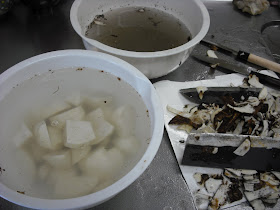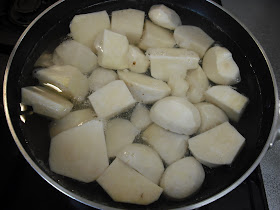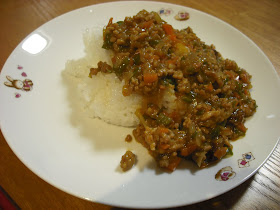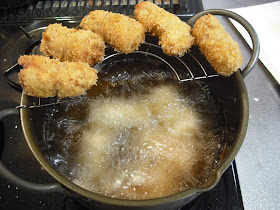I also made kuromame (black beans).
Usually, it takes 2-3 hours to simmer kuromame. I simmered mine in an easy way, using a thermos bottle.
250 g (approx. 2 cups = 400 ml) kuromame
1,200 ml water
300 g sugar
Small amount of salt
2 tbsp soy sauce
Rinse kuromame, put them in a thermos bottle. Boil water and add to the thermos bottle, add sugar, salt, and soy sauce. Let stand for 12 hours. Transfer to a pot and simmer on low heat for 30 min.
黒豆も作りました。
普通、黒豆を煮るには2~3時間かかります。私は簡単な方法で煮ました。魔法瓶を使う方法です。
黒豆 250 g(約2カップ=400 ml)
水 1,200 ml
砂糖 300 g
塩 少量
しょう油 大さじ2
黒豆を洗って、魔法瓶に入れる。お湯を沸かし、魔法瓶に入れ、砂糖、塩、しょう油も入れる。12時間放置する。鍋に移し、30分弱火で煮る。
12 hours later, I checked the beans, and found they were still rather tough. So, I decided to boil the liquid and "simmer" in the thermos bottle for more time.
12時間後、黒豆を調べると、まだ硬めでした。液を沸騰させて、もっと長く魔法瓶で「煮る」ことにしました。
Eight hours later, the beans were still rather tough. I gave up the thermos bottle method, and simmered in a pot for 30 min.
8時間後、黒豆はまだ硬めでした。魔法瓶を使った方法はあきらめ、鍋で30分煮ました。
Much less sweet than the store-bought kind. I personally liked them.
市販のよりずっと甘みは控えめです。私としては好きです。
December 30, 2011
Osechi Ryori 4: Tazukuri/御節(おせち)料理4:田作り
Instead of normal tazukuri, I made what is called "kozakana almond". Kozakana means small fish.
普通の田作りの代わりに、いわゆる「小魚アーモンド」を作りました。
100 g niboshi (small dried sardines for making dashi)
50 g almonds
60 g sugar
1 tbsp water
1. Put niboshi on a large plate, and microwave for 2-3 min. until crisp.
2. Cut each almond in two lengthwise, put them on a large plate, and microwave 2-3 min. until crisp.
3. In a pot, put sugar and water, dissolve sugar, bring to a boil, add niboshi, simmer on low to medium heat until sugar crystallize on each sardine.
4. Add almond.
煮干 100 g
アーモンド 50 g
砂糖 60 g
水 大さじ1
1. 煮干しを大きな皿に載せ、カリッとするまで2~3分電子レンジで加熱する。
2. アーモンドをそれぞれ縦に二つに切って、カリッとするまで2~3分電子レンジで加熱する。
3. 鍋に砂糖と水を入れ、砂糖を溶かし、沸騰させ、煮干しを加え、弱火~中火で砂糖が煮干しの表面で結晶化するまで火を通す。
4. アーモンドを足す。
Very, very tasty! I highly recommend it! Now I can say that almonds are optional. Niboshi alone should be tasty enough.
すごく、すごく美味しいです!お薦めです!アーモンドはなくてもいいと思います。煮干しだけで十分美味しいです。
普通の田作りの代わりに、いわゆる「小魚アーモンド」を作りました。
100 g niboshi (small dried sardines for making dashi)
50 g almonds
60 g sugar
1 tbsp water
1. Put niboshi on a large plate, and microwave for 2-3 min. until crisp.
2. Cut each almond in two lengthwise, put them on a large plate, and microwave 2-3 min. until crisp.
3. In a pot, put sugar and water, dissolve sugar, bring to a boil, add niboshi, simmer on low to medium heat until sugar crystallize on each sardine.
4. Add almond.
煮干 100 g
アーモンド 50 g
砂糖 60 g
水 大さじ1
1. 煮干しを大きな皿に載せ、カリッとするまで2~3分電子レンジで加熱する。
2. アーモンドをそれぞれ縦に二つに切って、カリッとするまで2~3分電子レンジで加熱する。
3. 鍋に砂糖と水を入れ、砂糖を溶かし、沸騰させ、煮干しを加え、弱火~中火で砂糖が煮干しの表面で結晶化するまで火を通す。
4. アーモンドを足す。
Very, very tasty! I highly recommend it! Now I can say that almonds are optional. Niboshi alone should be tasty enough.
すごく、すごく美味しいです!お薦めです!アーモンドはなくてもいいと思います。煮干しだけで十分美味しいです。
Osechi Ryori 3: Kobu (Kombu) Maki/御節(おせち)料理3:昆布巻き
I also made kobu (kombu) maki. Kobu maki usually have some fish in them such as herring and salmon, but I decided to make simple kobu maki with no filling.
昆布巻きも作りました。普通、昆布巻きには鰊(ニシン)や鮭(サケ)などの魚を入れますが、中身なしの昆布巻きを作ることにしました。
3 sheets of kombu:
昆布3枚:
Kanpyo (dried gourd shavings):
干瓢(かんぴょう):
The recipe I referred to says to rinse kombu quickly, but I skipped the rinsing, cut each sheet into four pieces to make 12 pieces in total, and soaked in cold water.
Edited to add: I didn't dispose of the water but used it to simmer the rolls.
参照したレシピでは、昆布をさっと洗うよう書いてありましたが、洗うのは止めて、それぞれを4つに切って、合計12枚にして、冷水に漬けました。
追記: 水は捨てずに、昆布巻きを煮るのに使いました。
I soaked the kanpyo in cold water for 3 min.
干瓢は冷水に3分漬けました。
Roll each sheet and fix with a toothpick at the middle. Cut the kanpyo into 24 strings of equal length, tie a square knot with one string on one side of each roll, and tie another knot with another string on the other side. Remove the toothpick, and cut the roll in two at the middle.
昆布をそれぞれ巻いて、真ん中で楊枝で留めます。干瓢を等しい長さのひも24本に切り、巻いた昆布の片方でひもを一本、こま結び(本結び)にして、もう一方も別のひもで結びます。楊枝を外して、昆布を真ん中で2つに切ります。
In a pot, put 600 ml water, 50 ml soy sauce, 50 ml mirin, 1 tbsp vinegar, and 24 rolls. Bring to a boil, and simmer until the liquid boils down.
鍋に水を600 ml、しょう油を50 ml、みりんを50 ml、お酢を大さじ1杯、昆布巻き24個入れ、沸騰させ、煮詰まるまで煮込みます。
Done!
完成!
昆布巻きも作りました。普通、昆布巻きには鰊(ニシン)や鮭(サケ)などの魚を入れますが、中身なしの昆布巻きを作ることにしました。
3 sheets of kombu:
昆布3枚:
Kanpyo (dried gourd shavings):
干瓢(かんぴょう):
The recipe I referred to says to rinse kombu quickly, but I skipped the rinsing, cut each sheet into four pieces to make 12 pieces in total, and soaked in cold water.
Edited to add: I didn't dispose of the water but used it to simmer the rolls.
参照したレシピでは、昆布をさっと洗うよう書いてありましたが、洗うのは止めて、それぞれを4つに切って、合計12枚にして、冷水に漬けました。
追記: 水は捨てずに、昆布巻きを煮るのに使いました。
I soaked the kanpyo in cold water for 3 min.
干瓢は冷水に3分漬けました。
Roll each sheet and fix with a toothpick at the middle. Cut the kanpyo into 24 strings of equal length, tie a square knot with one string on one side of each roll, and tie another knot with another string on the other side. Remove the toothpick, and cut the roll in two at the middle.
昆布をそれぞれ巻いて、真ん中で楊枝で留めます。干瓢を等しい長さのひも24本に切り、巻いた昆布の片方でひもを一本、こま結び(本結び)にして、もう一方も別のひもで結びます。楊枝を外して、昆布を真ん中で2つに切ります。
In a pot, put 600 ml water, 50 ml soy sauce, 50 ml mirin, 1 tbsp vinegar, and 24 rolls. Bring to a boil, and simmer until the liquid boils down.
鍋に水を600 ml、しょう油を50 ml、みりんを50 ml、お酢を大さじ1杯、昆布巻き24個入れ、沸騰させ、煮詰まるまで煮込みます。
Done!
完成!
Osechi Ryori 2: Simmered Yatsugashira/御節(おせち)料理2:八つ頭の煮物
I also made simmered yatsugashira.
八つ頭の煮物も作りました。
I used some of the yatsugashira given by my father.
父がくれた八つ頭を使いました。
I first cut them into large chunks, and put them in a bowl of water plus some vinegar (to prevent my hands from getting itchy).
まずは大きく切って、水とお酢(手がかゆくならないよう)を入れたボールに入れました。
Then I peeled each chunk, and put them in another bowl of water plus vinegar. I used four of my knives to do this job. I found that my Shigefusa nakiri was the easiest to use for this job.
そしてそれぞれの塊りを皮を剥いて、水とお酢の入った別のボールに入れました。包丁を4本使って皮を剥きました。この皮むきには重房の菜切りが一番使いやすかったです。
I put them in a pot (actually a frying pan for lack of a proper pot), add cold water, and brought to a boil. I parboiled for about 1 min. and drained.
鍋(実際は、適当な鍋がなかったのでフライパン)に入れ、水を入れ、沸騰させました。約1分下茹でして、お湯を切りました。
I put 600 ml water and parboiled yatsugashira in a pot (frying pan), brought to a boil, add 75 ml mirin.
鍋(フライパン)に水を600 mlと下茹でした八つ頭を入れ、沸騰させ、みりんを75 ml入れました。
Then, I put on the otoshi buta (drop lid), actually, some paper towels, and simmered on low heat for 10 min.
そして落し蓋(実際はキッチンペーパー数枚)をして、弱火で10分煮増した。
I forgot to mention that I also put on the lid.
言い忘れましたが、蓋もしました。
I tasted some, and decided to use my same old dashi, soy sauce, and mirin ratio of 8:1:1 for satoimo (taro). Thus, I added 75 ml soy sauce and 1 tsp instant dashi. I continued to simmer for another 10 min. (20 min. in total).
味見して、また里芋用のいつもの出汁、しょう油、みりんの割合(8:1:1)を使うことにしました。というわけで、しょう油を75 ml、出汁の素を小さじ1杯入れました。さらに10分(合計20分)煮ました。
Now I regret having followed a recipe that says to parboil yatsugashira and simmer for 20-30 minutes. I think I should have skipped parboiling and simmered for only 10 minutes, like I usually do.
八つ頭を下茹でして、20~30分煮るというレシピに従ったことを後悔しています。いつも通り、下茹では省略して、10分だけ煮ればよかったです。
八つ頭の煮物も作りました。
I used some of the yatsugashira given by my father.
父がくれた八つ頭を使いました。
I first cut them into large chunks, and put them in a bowl of water plus some vinegar (to prevent my hands from getting itchy).
まずは大きく切って、水とお酢(手がかゆくならないよう)を入れたボールに入れました。
Then I peeled each chunk, and put them in another bowl of water plus vinegar. I used four of my knives to do this job. I found that my Shigefusa nakiri was the easiest to use for this job.
そしてそれぞれの塊りを皮を剥いて、水とお酢の入った別のボールに入れました。包丁を4本使って皮を剥きました。この皮むきには重房の菜切りが一番使いやすかったです。
I put them in a pot (actually a frying pan for lack of a proper pot), add cold water, and brought to a boil. I parboiled for about 1 min. and drained.
鍋(実際は、適当な鍋がなかったのでフライパン)に入れ、水を入れ、沸騰させました。約1分下茹でして、お湯を切りました。
I put 600 ml water and parboiled yatsugashira in a pot (frying pan), brought to a boil, add 75 ml mirin.
鍋(フライパン)に水を600 mlと下茹でした八つ頭を入れ、沸騰させ、みりんを75 ml入れました。
Then, I put on the otoshi buta (drop lid), actually, some paper towels, and simmered on low heat for 10 min.
そして落し蓋(実際はキッチンペーパー数枚)をして、弱火で10分煮増した。
I forgot to mention that I also put on the lid.
言い忘れましたが、蓋もしました。
I tasted some, and decided to use my same old dashi, soy sauce, and mirin ratio of 8:1:1 for satoimo (taro). Thus, I added 75 ml soy sauce and 1 tsp instant dashi. I continued to simmer for another 10 min. (20 min. in total).
味見して、また里芋用のいつもの出汁、しょう油、みりんの割合(8:1:1)を使うことにしました。というわけで、しょう油を75 ml、出汁の素を小さじ1杯入れました。さらに10分(合計20分)煮ました。
Now I regret having followed a recipe that says to parboil yatsugashira and simmer for 20-30 minutes. I think I should have skipped parboiling and simmered for only 10 minutes, like I usually do.
八つ頭を下茹でして、20~30分煮るというレシピに従ったことを後悔しています。いつも通り、下茹では省略して、10分だけ煮ればよかったです。
Osechi Ryori 1: Kuri Kinton/御節(おせち)料理1:栗きんとん
I made chestnut-less kuri kinton. "Chestnut-less?", you might say. Kuri means chestnut, so kuri kinton should contain chestnuts. The thing is that chestnuts are not available around this time of year, and all kuri kinton recipes that I checked say to use store-bought, premade "kuri no kanroni" (candied chestnuts). I was quite sure that "kuri kinton" should taste great even without chestnuts, so I decided to make chestnut-less kuri kinton.
栗なしの栗きんとんを作りました。「栗なし?」と思われるかも知れません。栗きんとんには栗を入れるべきでしょうが、栗は今の時期は手に入らず、調べた栗きんとんのレシピーはどれも市販の出来あいの栗の甘露煮を使っていました。「栗きんとん」は栗が入っていなくても絶対美味しいと思ったので、栗なし栗きんとんを作ることにしたのです。
I used some of the sweet potatoes given by my father-in-law.
義父がくれたサツマイモを使いました。
I hate to cut sweet potatoes into smaller pieces. I simmered sweet potatoes whole on low heat for more than 50 minutes. NEVER use a microwave oven to cook sweet potatoes.
サツマイモを小さく切るのは嫌いです。丸ごと弱火で50分以上煮ました。サツマイモに火を通すのに決して電子レンジは使わないように。
Leave in the pot until cool.
冷めるまで鍋に入れておきます。
I cut one half of them into thick rounds. They will be a great snack for my family, especially my wife.
半分は厚い輪切りにしました。家族(特に妻)にとって美味しいおやつです。
I peeled the other half, put them in a bowl, and mashed with a wooden pestle (kine in Japanese).
もう半分は皮を剥いて、ボールに入れ、杵(きね)で潰しました。
(Sorry, blurry.)
ボケた写真ですみません)
Less than two minutes later, I mashed the completely. I tasted some and decided to add 2 tbsp sugar.
2分も経たぬうちに完全につぶせました。味見して砂糖を大さじ2杯足すことにしました。
Done!
完成!
栗なしの栗きんとんを作りました。「栗なし?」と思われるかも知れません。栗きんとんには栗を入れるべきでしょうが、栗は今の時期は手に入らず、調べた栗きんとんのレシピーはどれも市販の出来あいの栗の甘露煮を使っていました。「栗きんとん」は栗が入っていなくても絶対美味しいと思ったので、栗なし栗きんとんを作ることにしたのです。
I used some of the sweet potatoes given by my father-in-law.
義父がくれたサツマイモを使いました。
I hate to cut sweet potatoes into smaller pieces. I simmered sweet potatoes whole on low heat for more than 50 minutes. NEVER use a microwave oven to cook sweet potatoes.
サツマイモを小さく切るのは嫌いです。丸ごと弱火で50分以上煮ました。サツマイモに火を通すのに決して電子レンジは使わないように。
Leave in the pot until cool.
冷めるまで鍋に入れておきます。
I cut one half of them into thick rounds. They will be a great snack for my family, especially my wife.
半分は厚い輪切りにしました。家族(特に妻)にとって美味しいおやつです。
I peeled the other half, put them in a bowl, and mashed with a wooden pestle (kine in Japanese).
もう半分は皮を剥いて、ボールに入れ、杵(きね)で潰しました。
(Sorry, blurry.)
ボケた写真ですみません)
Less than two minutes later, I mashed the completely. I tasted some and decided to add 2 tbsp sugar.
2分も経たぬうちに完全につぶせました。味見して砂糖を大さじ2杯足すことにしました。
Done!
完成!
December 29, 2011
My Nukadoko on December 29/私のぬか床、12月29日
On December 29, my nukadoko looks like this:
12月29日、私のぬか床はこんな感じです。
Daikon leaves are nowhere to be found, cucumbers are very expensive these days, so I decided to freeze it tonight.
大根の葉っぱはどこにもないし、最近はきゅうりがとても高いので、今夜、冷凍することにしました。
I transferred the nukadoko to one I-Wrap bag.
ぬか床をアイラップに移しました。
I then put the I-Wrap bag in another, and put it in the freezer.
次にアイラップを別のアイラップに入れ、冷凍庫に入れました。
***
Today, I did a major house cleaning (oo souji in Japanese). It's customary in Japan to do a major house cleaning around this time of year, just before the end of the year, to get ready for the New Year.
今日は大掃除(おおそうじ)をしました。日本では、一年のうちの今頃、年の終わり頃に、新年を迎えるため大掃除をする習慣があります。
Tomorrow, I will start making some osechi ryori! To be more precise, I have already started to make simmered kuromame (black beans) in a thermos bottle tonight.
明日はおせち料理を作り始めます!正確には、もう今夜、魔法瓶で黒豆を作り始めました。
12月29日、私のぬか床はこんな感じです。
Daikon leaves are nowhere to be found, cucumbers are very expensive these days, so I decided to freeze it tonight.
大根の葉っぱはどこにもないし、最近はきゅうりがとても高いので、今夜、冷凍することにしました。
I transferred the nukadoko to one I-Wrap bag.
ぬか床をアイラップに移しました。
I then put the I-Wrap bag in another, and put it in the freezer.
次にアイラップを別のアイラップに入れ、冷凍庫に入れました。
***
Today, I did a major house cleaning (oo souji in Japanese). It's customary in Japan to do a major house cleaning around this time of year, just before the end of the year, to get ready for the New Year.
今日は大掃除(おおそうじ)をしました。日本では、一年のうちの今頃、年の終わり頃に、新年を迎えるため大掃除をする習慣があります。
Tomorrow, I will start making some osechi ryori! To be more precise, I have already started to make simmered kuromame (black beans) in a thermos bottle tonight.
明日はおせち料理を作り始めます!正確には、もう今夜、魔法瓶で黒豆を作り始めました。
December 28, 2011
Dry Curry/ドライカレー
As part of supper last night, I made cream stew using store-bought pre-made stew roux. All my family loved it. My daughter remarked casually, "The dry curry we had at Tsumugi Banya (Tsumugi Cafe) was very delicious. I want to have dry curry."
So I just had to make dry curry as part of supper tonight.
I went shopping with my daughter in the morning to buy some raisin. My daughter insisted that dry curry should contain raisin.
Ingredients:
350 g ground pork
2 medium onions
1/4 carrot
4 green pepper
Appropriate amount of raisin
2 cubes premade curry roux
1 tsp instant dashi
1 tbsp soy sauce
1 tbsp mirin
1 tbsp sake
昨日の夕飯には市販でシチューのルーを使ってクリームシチューを作りました。もちろん、家族全員好きです。娘が何気なくこう言いました、「つむぎ番屋(つむぎカフェ)で食べたドライカレーは美味しかった。ドライカレーが食べたい」。
というわけで、今日の夕飯にはドライカレーを作りました。
午前中、娘とレーズンを買いに行きました。娘がドライカレーにはレーズンを入れないといけないと言うので。
材料:
豚の挽き肉 350 g
玉ねぎ 中2個
にんじん 1/4本
ピーマン4個
レーズン 適量
カレールー2個
出汁の素 小さじ1
しょう油 大さじ1
みりん 大さじ1
お酒 大さじ1
My daughter's portion:
娘の分:
My daughter said it was good, although it was a little soggy, but I thought that something was missing... Later I did some googling and I thought maybe I should have added some tomato ketchup and tonkatsu sauce to add some body.
娘はちょっと水っぽいけど美味しいと言ってくれましたが、私は何かが足りないと思いました。後でグーグルして、トマトケチャップや豚カツソースを入れてコクを出すべきだったと思いました。
So I just had to make dry curry as part of supper tonight.
I went shopping with my daughter in the morning to buy some raisin. My daughter insisted that dry curry should contain raisin.
Ingredients:
350 g ground pork
2 medium onions
1/4 carrot
4 green pepper
Appropriate amount of raisin
2 cubes premade curry roux
1 tsp instant dashi
1 tbsp soy sauce
1 tbsp mirin
1 tbsp sake
昨日の夕飯には市販でシチューのルーを使ってクリームシチューを作りました。もちろん、家族全員好きです。娘が何気なくこう言いました、「つむぎ番屋(つむぎカフェ)で食べたドライカレーは美味しかった。ドライカレーが食べたい」。
というわけで、今日の夕飯にはドライカレーを作りました。
午前中、娘とレーズンを買いに行きました。娘がドライカレーにはレーズンを入れないといけないと言うので。
材料:
豚の挽き肉 350 g
玉ねぎ 中2個
にんじん 1/4本
ピーマン4個
レーズン 適量
カレールー2個
出汁の素 小さじ1
しょう油 大さじ1
みりん 大さじ1
お酒 大さじ1
My daughter's portion:
娘の分:
My daughter said it was good, although it was a little soggy, but I thought that something was missing... Later I did some googling and I thought maybe I should have added some tomato ketchup and tonkatsu sauce to add some body.
娘はちょっと水っぽいけど美味しいと言ってくれましたが、私は何かが足りないと思いました。後でグーグルして、トマトケチャップや豚カツソースを入れてコクを出すべきだったと思いました。
December 23, 2011
Oden for Christmas/クリスマスにおでん
I'm still playing with the five new knives I got recently. This morning, I cut a block of konnyaku with my new sashimi knife. I thought, "What will I do with this konnyaku?" I decided to make oden partly because we still have several daikon left in our house and mainly because I wanted to have something light for the Christmas season. I'm still on a diet, and I don't want to gain weight in the holiday season!
最近買った新しい五本の包丁でまだ遊んでいます。今朝は、刺身包丁でこんにゃくを切りました。「このこんにゃくをどうしよう?」と思いましたが、おでんを作ることにしました。家にまだ大根が残っているし、何より、クリスマスシーズンに何か軽いものを食べたいと思ったので。まだダイエットを続けていて、休日の間に体重を増やしたくないので。
Eight eggs, 1 1/2 daikon, and 16 rectangles of konnyaku made from a single block
卵8個、大根1 1/2本、一つのこんにゃくから作った三角形16個。
While cutting the konnyaku with the sashimi knife, I accidentally cut myself!
刺身包丁でこんにゃくを切っている最中、指を切ってしまいました!
The cut is very shallow but rather long, requiring two Band-Aids.
傷はとても浅かったですが、かなり長くて、バンドエイドが2つ要りました。
Now I have four knives in the storage space under the sink:
Left to right: New sashimi knife, Shigefusa petty (paring) knife, new mioroshi-deba knife, and Shigefusa nakiri.
流しの下の収納スペースには四本の包丁を挿しました:
左から右へ: 新しい刺身包丁、重房のペティーナイフ、新しい身おろし出刃包丁、重房の菜切り。
And, today, by using two empty milk cartons, I have made a storage box for the three new knives, santoku, petty (paring) knife, and mukimono knife:
そして、今日は、牛乳パックを2つ使って、新しい包丁3本(三徳、ペティーナイフ、剥き物包丁)の収納ボックスを作りました。
Don't laugh! I'm quite satisfied with my idea (laugh).
笑わないように!自分のアイディアにかなり満足してるので(笑)。
最近買った新しい五本の包丁でまだ遊んでいます。今朝は、刺身包丁でこんにゃくを切りました。「このこんにゃくをどうしよう?」と思いましたが、おでんを作ることにしました。家にまだ大根が残っているし、何より、クリスマスシーズンに何か軽いものを食べたいと思ったので。まだダイエットを続けていて、休日の間に体重を増やしたくないので。
Eight eggs, 1 1/2 daikon, and 16 rectangles of konnyaku made from a single block
卵8個、大根1 1/2本、一つのこんにゃくから作った三角形16個。
While cutting the konnyaku with the sashimi knife, I accidentally cut myself!
刺身包丁でこんにゃくを切っている最中、指を切ってしまいました!
The cut is very shallow but rather long, requiring two Band-Aids.
傷はとても浅かったですが、かなり長くて、バンドエイドが2つ要りました。
Now I have four knives in the storage space under the sink:
Left to right: New sashimi knife, Shigefusa petty (paring) knife, new mioroshi-deba knife, and Shigefusa nakiri.
流しの下の収納スペースには四本の包丁を挿しました:
左から右へ: 新しい刺身包丁、重房のペティーナイフ、新しい身おろし出刃包丁、重房の菜切り。
And, today, by using two empty milk cartons, I have made a storage box for the three new knives, santoku, petty (paring) knife, and mukimono knife:
そして、今日は、牛乳パックを2つ使って、新しい包丁3本(三徳、ペティーナイフ、剥き物包丁)の収納ボックスを作りました。
Don't laugh! I'm quite satisfied with my idea (laugh).
笑わないように!自分のアイディアにかなり満足してるので(笑)。
December 22, 2011
Winter Solstice in 2011/2011年の冬至
Just wanted to remind you again that the winter solstice falls on today, December 22, this year.
It is customary in Japan to have kabocha and take a "yuzu buro" (bathe in a bathtub with yuzu floating on the water) on this particular day.
今年の冬至は12月22日だと知らせたかっただけです。
日本では、この日にカボチャを食べ、柚子風呂に入る(柚子を浮かべた風呂に入る)習慣があります。
I simmered one small kabocha and made kabocha soup with two others.
小さなかぼちゃを一つ煮て、他の二つでかぼちゃスープを作りました。
I took a yuzu buro with two yuzu.
柚子を二つ入れた柚子風呂に入りました。
It is customary in Japan to have kabocha and take a "yuzu buro" (bathe in a bathtub with yuzu floating on the water) on this particular day.
今年の冬至は12月22日だと知らせたかっただけです。
日本では、この日にカボチャを食べ、柚子風呂に入る(柚子を浮かべた風呂に入る)習慣があります。
I simmered one small kabocha and made kabocha soup with two others.
小さなかぼちゃを一つ煮て、他の二つでかぼちゃスープを作りました。
I took a yuzu buro with two yuzu.
柚子を二つ入れた柚子風呂に入りました。
December 21, 2011
A Set of Five Kitchen Knives from Watanabe Blade/渡辺刃物の包丁5点セット
I ordered a set of five kitchen knives from Watanabe Blade a few days ago, and received it today.
数日前、渡辺刃物に包丁5点セットを注文して、今日、届きました。
For information about this set, click
here (Japanese verion) or
here (English version).
I will provide more detailed information about the knives after I test them all.
すべて試してから、もっと詳しい情報を載せます。
数日前、渡辺刃物に包丁5点セットを注文して、今日、届きました。
For information about this set, click
here (Japanese verion) or
here (English version).
I will provide more detailed information about the knives after I test them all.
すべて試してから、もっと詳しい情報を載せます。
December 19, 2011
Aji Fry Don/アジフライ丼
Like I said previously, my lunch is usually some leftovers plus something extra unless I have the guts to splurge a little.
前にも言った通り、私の昼食は大抵、残り物+何かです。ちょっと贅沢する勇気がない限りは。
Today, I had to deal with them.
今日は、これをやっつけないと。
Aji fries my children left uneaten for supper last Thursday.
先週の木曜日の夕飯で子供たちが食べ残したアジフライ。
At first, I thought I would make a sandwich with them, but I changed my mind and decided to make aji fry don.
The recipe is the same as that for oyakodon and katsudon. I used only one egg, though.
最初はサンドイッチを作ろうと思ったのですが、気が変わって、アジフライ丼を作ることにしました。
レシピーは親子丼やカツ丼と同じです。卵は1個しか使いませんでしたが。
About five minutes later, the unappetizing aji fries turned into something that looked delicious (at least for me).
約5分後、まずそうなアジフライが、(少なくとも私には)美味しそうに見える物に変わりました。
In fact, I had this strange feeling that I was in a restaurant like Shinya Shokudo (laugh).
実際の話、深夜食堂のようなお店にいるような変な気持ちになりました。
前にも言った通り、私の昼食は大抵、残り物+何かです。ちょっと贅沢する勇気がない限りは。
Today, I had to deal with them.
今日は、これをやっつけないと。
Aji fries my children left uneaten for supper last Thursday.
先週の木曜日の夕飯で子供たちが食べ残したアジフライ。
At first, I thought I would make a sandwich with them, but I changed my mind and decided to make aji fry don.
The recipe is the same as that for oyakodon and katsudon. I used only one egg, though.
最初はサンドイッチを作ろうと思ったのですが、気が変わって、アジフライ丼を作ることにしました。
レシピーは親子丼やカツ丼と同じです。卵は1個しか使いませんでしたが。
About five minutes later, the unappetizing aji fries turned into something that looked delicious (at least for me).
約5分後、まずそうなアジフライが、(少なくとも私には)美味しそうに見える物に変わりました。
In fact, I had this strange feeling that I was in a restaurant like Shinya Shokudo (laugh).
実際の話、深夜食堂のようなお店にいるような変な気持ちになりました。
December 18, 2011
Daikon Rolled with Meat, etc./大根の肉巻きなど
As part of supper tonight, I made daikon rolled with meat and other deep-fried items.
今日の夕飯には、大根の肉巻きと他の揚げ物を作りました。
First, a photo of snow on the road just in front of my house yesterday morning:
まずは、昨日の朝、家のすぐ前の道の雪:
I "roasted" some of the hatomugi (Job's Tears) given by my father in the toaster oven.
父からもらったはと麦を少し、オーブントースターで「煎り」ました。
That's another story.
別の話ですが。
I made "sweet potato" with a little help from my daughter.
「スイートポテト」を作りました。娘が少し手伝ってくれました。
That's another story, too.
これも別の話です。
Make ten sheets of daikon measuring approx. 10 x 8 x 0.3 cm. Put them in a bowl, add some (1 tsp salt) salt, rub well, and let stand. Roll each sheet with a thin slice of pork.
約10 x 8 x 0.3 cmの薄い大根のシートを作ります。ボールに入れ、塩を少々(小さじ1)入れ、よくもみ、放置します。各シートを豚の薄切りと一緒に巻きます。
I know that my children wouldn't be satisfied with the niku maki alone, so I made french fries (called fried potato in japanese), too.
子供たちは肉巻きだけでは満足しないと分かっているので、フライドポテトも作りました。
And, meat balls, too.
それから、肉団子も。
Ground pork + grated ginger + one egg + potato starch + some salt
豚の挽き肉+おろし生姜+卵1個+片栗粉+塩少々
Sprinkle some pepper (but no salt, because the daikon sheets are already salted) on the rolls, dust with flour, coat with beaten egg, and coat with panko.
胡椒をかけ(塩はかけません。大根に塩味がついているので)、小麦粉をつけ、溶き卵をつけ、パン粉をつけます。
Deep-fry for 3-4 min. at 180C.
180Cで3~4分、揚げます。
I had mine with tonkatsu sauce and lemon juice.
私は豚カツソースとレモンジュースで食べました。
Yummy!
美味しかったです!
今日の夕飯には、大根の肉巻きと他の揚げ物を作りました。
First, a photo of snow on the road just in front of my house yesterday morning:
まずは、昨日の朝、家のすぐ前の道の雪:
I "roasted" some of the hatomugi (Job's Tears) given by my father in the toaster oven.
父からもらったはと麦を少し、オーブントースターで「煎り」ました。
That's another story.
別の話ですが。
I made "sweet potato" with a little help from my daughter.
「スイートポテト」を作りました。娘が少し手伝ってくれました。
That's another story, too.
これも別の話です。
Make ten sheets of daikon measuring approx. 10 x 8 x 0.3 cm. Put them in a bowl, add some (1 tsp salt) salt, rub well, and let stand. Roll each sheet with a thin slice of pork.
約10 x 8 x 0.3 cmの薄い大根のシートを作ります。ボールに入れ、塩を少々(小さじ1)入れ、よくもみ、放置します。各シートを豚の薄切りと一緒に巻きます。
I know that my children wouldn't be satisfied with the niku maki alone, so I made french fries (called fried potato in japanese), too.
子供たちは肉巻きだけでは満足しないと分かっているので、フライドポテトも作りました。
And, meat balls, too.
それから、肉団子も。
Ground pork + grated ginger + one egg + potato starch + some salt
豚の挽き肉+おろし生姜+卵1個+片栗粉+塩少々
Sprinkle some pepper (but no salt, because the daikon sheets are already salted) on the rolls, dust with flour, coat with beaten egg, and coat with panko.
胡椒をかけ(塩はかけません。大根に塩味がついているので)、小麦粉をつけ、溶き卵をつけ、パン粉をつけます。
Deep-fry for 3-4 min. at 180C.
180Cで3~4分、揚げます。
I had mine with tonkatsu sauce and lemon juice.
私は豚カツソースとレモンジュースで食べました。
Yummy!
美味しかったです!























































